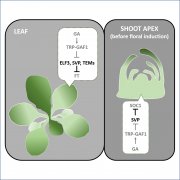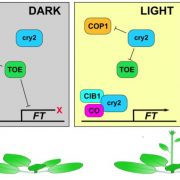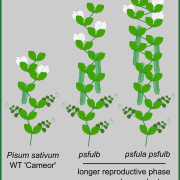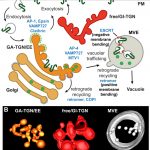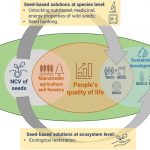Florigen sequestration in cellular membranes modulates temperature-responsive flowering (Science)($)
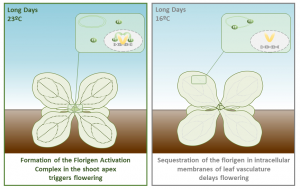 The existence of the FLORIGEN – a mobile floral activator produced in the leaf and transported to the apex – was hypothesized almost a century ago but its molecular nature remained elusive for decades. In the last 15 years, independent groups demonstrated that members of the Phosphatidyl Ethanolamine-Binding Proteins (PEBP) family act as florigen in several plant species. Although PEBPs are not able to directly bind DNA, they interact with regulatory proteins to form the Florigen Activation Complex, which controls the expression of genes involved in flower development in the shoot apical meristem. Here, Susila and coworkers investigated the ability of the Arabidopsis florigen, FLOWERING LOCUS T (FT), to bind lipids in vitro and in vivo. They found that FT preferentially interacts with phosphatidylglycerol (PG, negatively charged phospholipids) and localizes to some intracellular membranes (e.g. chloroplast) in addition to the nucleus. The authors also discovered that mutants impaired in PG biosynthesis flowered earlier than wildtypes under inductive long days at 16ºC, likely due to increased accumulation of FT in the soluble fraction. Additional experiments indicated that PG sequestered FT in chloroplasts and trans-Golgi, thus delaying the floral transition in response to lower temperature. This study provides an additional layer of complexity to the regulation of the florigen: while most of the components of the photoperiod pathway control the expression of FT in the leaf vasculature, PG control the transport of FT from leaf companion cells to sieve elements. These mechanisms allow fine tuning of flowering time in response to not only daylength but also temperature seasonal changes. (Summary and image by Michela Osnato @michela_osnato). Science 10.1126/science.abh4054
The existence of the FLORIGEN – a mobile floral activator produced in the leaf and transported to the apex – was hypothesized almost a century ago but its molecular nature remained elusive for decades. In the last 15 years, independent groups demonstrated that members of the Phosphatidyl Ethanolamine-Binding Proteins (PEBP) family act as florigen in several plant species. Although PEBPs are not able to directly bind DNA, they interact with regulatory proteins to form the Florigen Activation Complex, which controls the expression of genes involved in flower development in the shoot apical meristem. Here, Susila and coworkers investigated the ability of the Arabidopsis florigen, FLOWERING LOCUS T (FT), to bind lipids in vitro and in vivo. They found that FT preferentially interacts with phosphatidylglycerol (PG, negatively charged phospholipids) and localizes to some intracellular membranes (e.g. chloroplast) in addition to the nucleus. The authors also discovered that mutants impaired in PG biosynthesis flowered earlier than wildtypes under inductive long days at 16ºC, likely due to increased accumulation of FT in the soluble fraction. Additional experiments indicated that PG sequestered FT in chloroplasts and trans-Golgi, thus delaying the floral transition in response to lower temperature. This study provides an additional layer of complexity to the regulation of the florigen: while most of the components of the photoperiod pathway control the expression of FT in the leaf vasculature, PG control the transport of FT from leaf companion cells to sieve elements. These mechanisms allow fine tuning of flowering time in response to not only daylength but also temperature seasonal changes. (Summary and image by Michela Osnato @michela_osnato). Science 10.1126/science.abh4054


